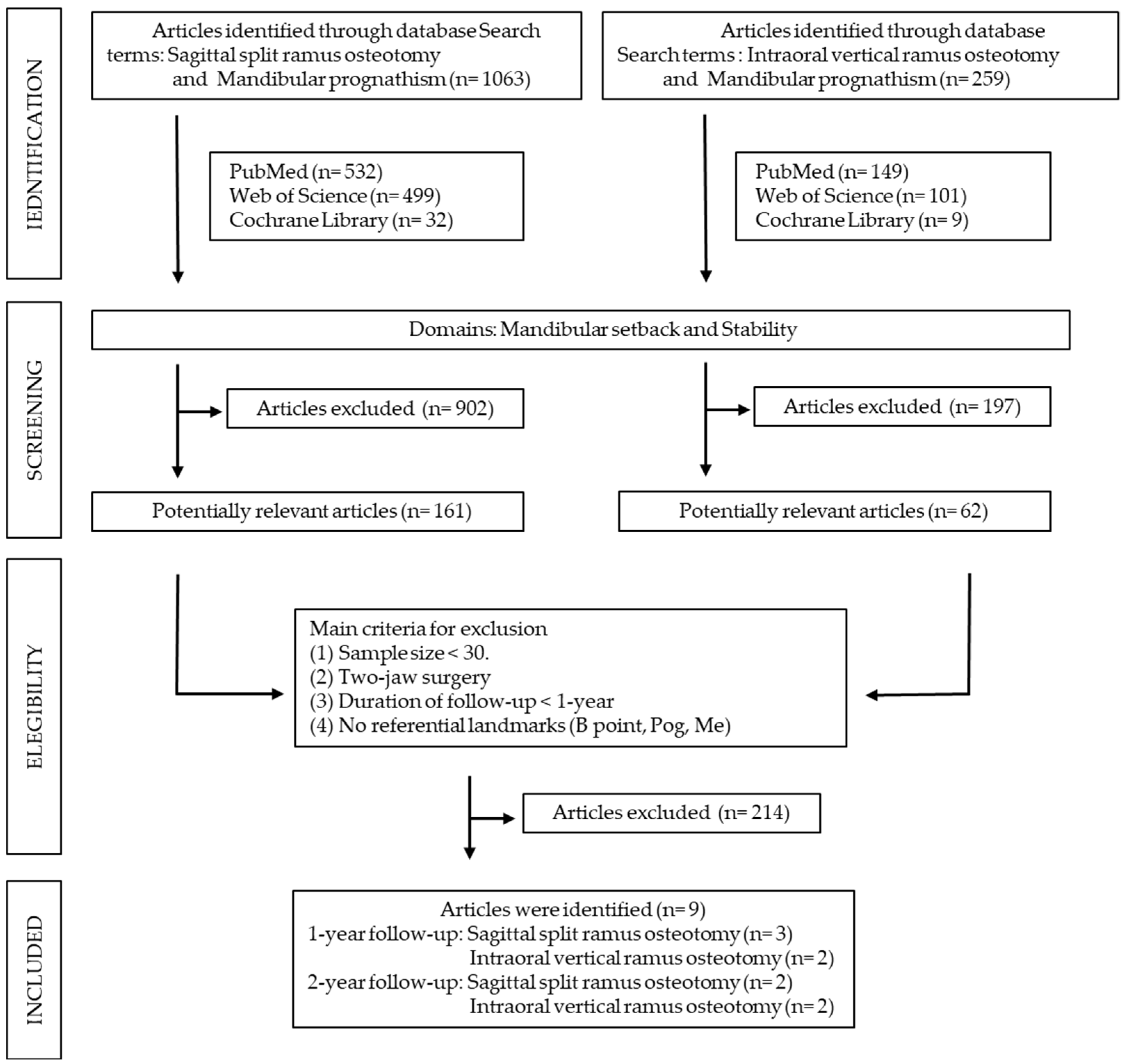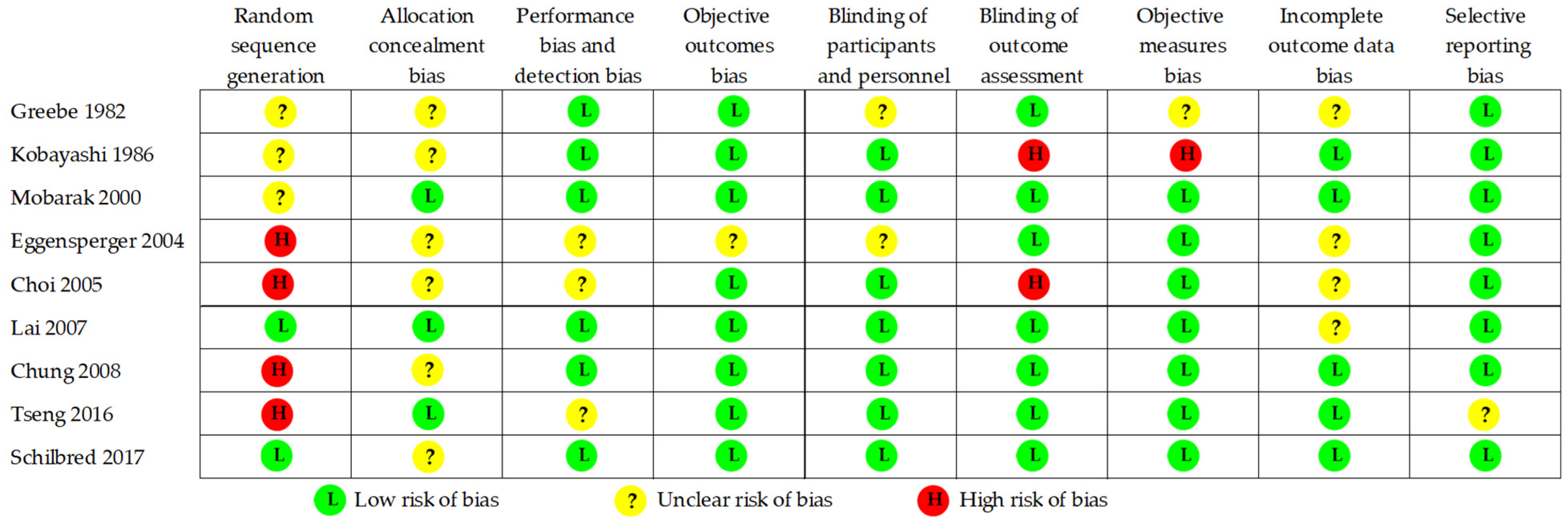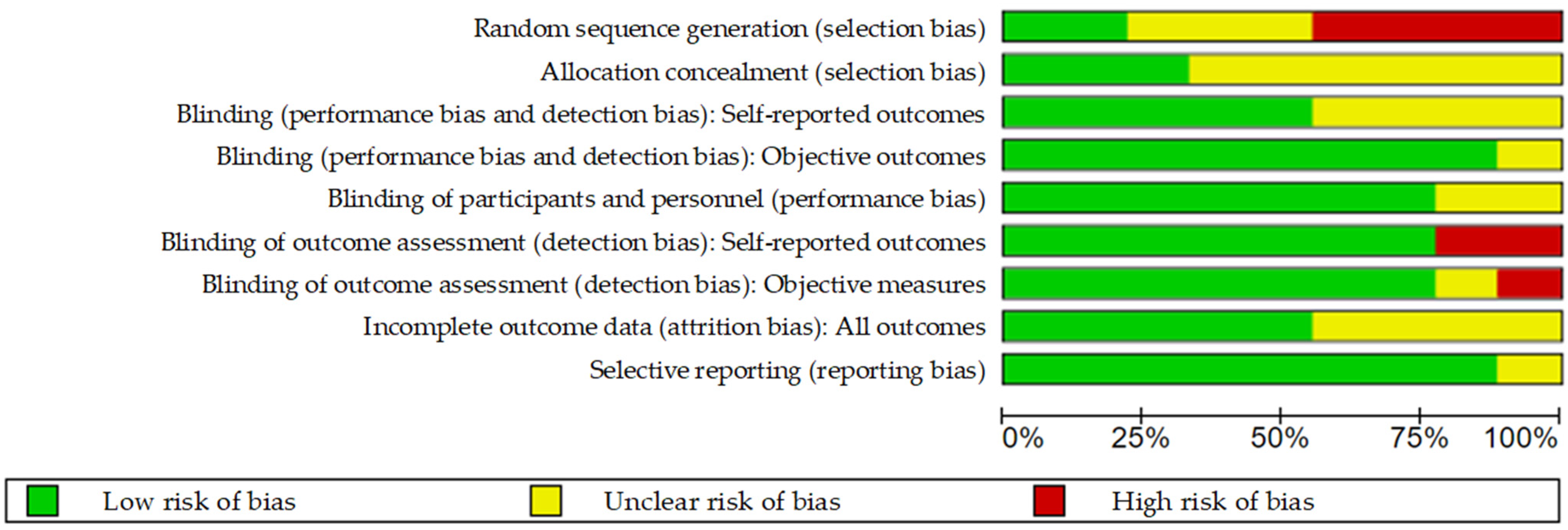Skeletal Stability after Mandibular Setback via Sagittal Split Ramus Osteotomy Verse Intraoral Vertical Ramus Osteotomy: A Systematic Review
Abstract
:1. Introduction
2. Materials and Methods
2.1. Search Strategy
2.2. Study Selection and Eligibility
2.3. Data Extraction and Analysis of Surgical Stability
3. Results
3.1. Data Consolidation Analysis
3.2. Study Selection and Eligibility
3.3. Data Extraction and Analysis of Surgical Stability
4. Discussion
4.1. Risk of Bias Assessment
4.2. Detachment of Pterygomandibular Sling
4.3. Condylar Sag
4.4. Proximal and Distal Segment Fixation
4.5. Maxillomandibular Fixation
4.6. Amount of Setback
5. Conclusions
Author Contributions
Funding
Data Availability Statement
Conflicts of Interest
References
- Bell, W.H.; Hall, H.D.; White, R.P.; Proffit, W.R. Mandibular excess. In Surgical Correction of Dentofacial Deformities; W.B. Saunders Co.: Philadelphia, PA, USA, 1980. [Google Scholar]
- Bell, W.H.; Schendel, S.A. Biologic basis for modification of the sagittal ramus split operation. J. Oral Surg. 1977, 35, 362–369. [Google Scholar]
- Calderon, S.; Gal, G.; Anavi, Y.; Gonshorowitz, M. Techniques for ensuring the lateral position of the proximal segment following intraoral vertical ramus osteotomy. J. Oral Maxillofac. Surg. 1992, 50, 1044–1047. [Google Scholar] [CrossRef]
- Hall, H.D.; McKenna, S.J. Further refinement and evaluation of intraoral vertical ramus osteotomy. J. Oral Maxillofac. Surg. 1987, 45, 684–688. [Google Scholar] [CrossRef]
- McKenna, S.J.; King, E.E. Intraoral Vertical Ramus Osteotomy Procedure and Technique. Atlas Oral Maxillofac. Surg. Clin. N. Am. 2016, 24, 37–43. [Google Scholar] [CrossRef]
- Roh, Y.C.; Shin, S.H.; Kim, S.S.; Sandor, G.K.; Kim, Y.D. Skeletal stability and condylar position related to fixation method following mandibular setback with bilateral sagittal split ramus osteotomy. J. Craniomaxillofac. Surg. 2014, 42, 1958–1963. [Google Scholar] [CrossRef]
- Tornes, K. Osteotomy length and postoperative stability in vertical subcondylar ramus osteotomy. Acta Odontol. Scand. 1989, 47, 81–88. [Google Scholar] [CrossRef] [PubMed]
- Wolford, L.M.; Bennett, M.A.; Rafferty, C.G. Modification of the mandibular ramus sagittal split osteotomy. Oral Surg. Oral Med Oral Pathol. 1987, 64, 146–155. [Google Scholar] [CrossRef]
- Wolford, L.M. The sagittal split ramus osteotomy as the preferred treatment for mandibular prognathism. J. Oral Maxillofac. Surg. 2000, 58, 310–312. [Google Scholar] [CrossRef]
- Ghali, G.E.; Sikes, J.W., Jr. Intraoral vertical ramus osteotomy as the preferred treatment for mandibular prognathism. J. Oral Maxillofac. Surg. 2000, 58, 313–315. [Google Scholar] [CrossRef]
- Page, M.J.; McKenzie, J.E.; Bossuyt, P.M.; Boutron, I.; Hoffmann, T.C.; Mulrow, C.D.; Shamseer, L.; Tetzlaff, J.M.; Akl, E.A.; Brennan, S.E. The PRISMA 2020 statement: An updated guideline for reporting systematic reviews. J. Clin. Epidemiol. 2021, 134, 178–189. [Google Scholar] [CrossRef] [PubMed]
- Greebe, R.B.; Tuinzing, D.B. Overcorrection and relapse after the intraoral vertical ramus osteotomy. A one-year postoperative review of thirty-five patients. Oral Surg. Oral Med. Oral Pathol. 1982, 54, 382–384. [Google Scholar] [CrossRef]
- Kobayashi, T.; Watanabe, I.; Ueda, K.; Nakajima, T. Stability of the mandible after sagittal ramus osteotomy for correction of prognathism. J. Oral Maxillofac. Surg. 1986, 44, 693–697. [Google Scholar] [CrossRef]
- Mobarak, K.A.; Krogstad, O.; Espeland, L.; Lyberg, T. Long-term stability of mandibular setback surgery: A follow-up of 80 bilateral sagittal split osteotomy patients. Int. J. Adult. Orthodon. Orthognath. Surg. 2000, 15, 83–95. [Google Scholar]
- Eggensperger, N.; Smolka, W.; Rahal, A.; Iizuka, T. Skeletal relapse after mandibular advancement and setback in single-jaw surgery. J. Oral Maxillofac. Surg. 2004, 62, 1486–1496. [Google Scholar] [CrossRef]
- Choi, B.H.; Zhu, S.J.; Han, S.G.; Huh, J.Y.; Kim, B.Y.; Jung, J.H. The need for intermaxillary fixation in sagittal split osteotomy setbacks with bicortical screw fixation. Oral Surg. Oral Med. Oral Pathol. Oral Radiol. Endod. 2005, 100, 292–295. [Google Scholar] [CrossRef] [PubMed]
- Lai, S.S.; Tseng, Y.C.; Huang, I.Y.; Yang, Y.H.; Shen, Y.S.; Chen, C.M. Skeletal changes after modified intraoral vertical ramus osteotomy for correction of mandibular prognathism. J. Plast. Reconstr. Aesthet. Surg. 2007, 60, 139–145. [Google Scholar] [CrossRef]
- Chung, I.H.; Yoo, C.K.; Lee, E.K.; Ihm, J.A.; Park, C.J.; Lim, J.S.; Hwang, K.G. Postoperative stability after sagittal split ramus osteotomies for a mandibular setback with monocortical plate fixation or bicortical screw fixation. J. Oral Maxillofac. Surg. 2008, 66, 446–452. [Google Scholar] [CrossRef] [PubMed]
- Tseng, Y.C.; Hsu, K.J.; Chen, K.K.; Wu, J.H.; Chen, C.M. Relationship between Frontal Gap and Postoperative Stability in the Treatment of Mandibular Prognathism. Biomed. Res. Int. 2016, 2016, 7046361. [Google Scholar] [CrossRef] [PubMed] [Green Version]
- Schilbred Eriksen, E.; Wisth, P.J.; Løes, S.; Moen, K. Skeletal and dental stability after intraoral vertical ramus osteotomy: A long-term follow-up. Int. J. Oral Maxillofac. Surg. 2017, 46, 72–79. [Google Scholar] [CrossRef] [PubMed]
- Politi, M.; Costa, F.; Cian, R.; Polini, F.; Robiony, M. Stability of skeletal class III malocclusion after combined maxillary and mandibular procedures: Rigid internal fixation versus wire osteosynthesis of the mandible. J. Oral Maxillofac. Surg. 2004, 62, 169–181. [Google Scholar] [CrossRef]
- Hsu, S.S.; Huang, C.S.; Chen, P.K.; Ko, E.W.; Chen, Y.R. The stability of mandibular prognathism corrected by bilateral sagittal split osteotomies: A comparison of bi-cortical osteosynthesis and mono-cortical osteosynthesis. Int. J. Oral Maxillofac. Surg. 2012, 41, 142–149. [Google Scholar] [CrossRef]
- Ueki, K.; Moroi, A.; Yoshizawa, K.; Hotta, A.; Tsutsui, T.; Fukaya, K.; Hiraide, R.; Takayama, A.; Tsunoda, T.; Saito, Y. Comparison of skeletal stability after sagittal split ramus osteotomy among mono-cortical plate fixation, bi-cortical plate fixation, and hybrid fixation using absorbable plates and screws. J. Craniomaxillofac. Surg. 2017, 45, 178–182. [Google Scholar] [CrossRef] [PubMed]
- Athanasiou, A.E.; Mavreas, D.; Toutountzakis, N.; Ritzau, M. Skeletal stability after surgical correction of mandibular prognathism by vertical ramus osteotomy. Eur. J. Orthod. 1992, 14, 117–124. [Google Scholar] [CrossRef]
- Harada, K.; Tajima, K.; Enomoto, S. Stability after sagittal split ramus osteotomy without post-operative maxillomandibular fixation in the treatment of prognathic patients with asymmetric mandibles. Clin. Orthod. Res. 1999, 2, 27–33. [Google Scholar] [CrossRef] [PubMed]
- Harada, K.; Watanabe, M.; Okada, Y.; Enomoto, S. Mandibular stability after sagittal split ramus osteotomy without post-operative maxillomandibular fixation in the treatment of prognathic patients with symmetric mandibles. Clin. Orthod. Res. 1998, 1, 44–51. [Google Scholar] [CrossRef]
- Yamada, T.; Mishima, K.; Matsumura, T.; Moritani, N.; Sugahara, T. Mandibular stability after SSRO with or without postoperative maxillo-mandibular fixation for Class III malocclusion. Oral Maxillofac. Surg. 2008, 12, 177–180. [Google Scholar] [CrossRef]
- Yamada, T.; Mishima, K.; Moritani, N.; Matsumura, T.; Janune, D.; Sugahara, T. Postoperative course after SSRO in mandibular asymmetries with or without MMF. Oral Maxillofac. Surg. 2009, 13, 27–31. [Google Scholar] [CrossRef]
- Al-Delayme, R.M.; Al-Khen, M. Skeletal Relapse After Mandibular Setback in Bi Max Surgery: Intraoral Vertical Ramus versus Bilateral Sagittal Split Osteotomies. J. Maxillofac. Oral Surg. 2014, 13, 471–477. [Google Scholar] [CrossRef] [Green Version]
- Takahara, N.; Kimura, A.; Tomomatsu, N.; Nakakuki, K.; Yoda, T. Does the amount of mandibular setback during bimaxillary surgery correlate with the degree of surgical relapse? Oral Surg. Oral Med. Oral Pathol. Oral Radiol. 2020, 129, 447–452. [Google Scholar] [CrossRef] [PubMed]
- Yang, H.J.; Hwang, S.J. Contributing factors to intraoperative clockwise rotation of the proximal segment as a relapse factor after mandibular setback with sagittal split ramus osteotomy. J. Craniomaxillofac. Surg. 2014, 42, 57–63. [Google Scholar] [CrossRef]
- Chen, C.M.; Chen, M.Y.; Cheng, J.H.; Chen, K.J.; Tseng, Y.C. Facial profile and frontal changes after bimaxillary surgery in patients with mandibular prognathism. J. Formos. Med. Assoc. 2018, 117, 632–639. [Google Scholar] [CrossRef] [PubMed]
- Choi, S.H.; Kang, D.Y.; Cha, J.Y.; Jung, Y.S.; Yu, H.S.; Park, H.S.; Hwang, C.J. Major factors contributing to anterior and posterior relapse after intraoral vertical ramus osteotomy. J. Craniomaxillofac. Surg. 2016, 44, 413–420. [Google Scholar] [CrossRef] [PubMed]
- Tseng, Y.C.; Hsiao, S.Y.; Cheng, J.H.; Hsu, K.J.; Chen, C.M. Postoperative Skeletal Stability and Pharyngeal Airway: Counterclockwise versus Clockwise Rotation during Mandibular Setback Surgery. Biomed. Res. Int. 2020, 2020, 3283080. [Google Scholar] [CrossRef] [PubMed]
- Mah, D.H.; Kim, S.G.; Oh, J.S.; You, J.S.; Jung, S.Y.; Kim, W.G.; Yu, K.H. Comparative study of postoperative stability between conventional orthognathic surgery and a surgery-first orthognathic approach after bilateral sagittal split ramus osteotomy for skeletal class III correction. J. Korean Assoc. Oral Maxillofac. Surg. 2017, 43, 23–28. [Google Scholar] [CrossRef] [PubMed] [Green Version]
- Ko, E.W.; Lin, S.C.; Chen, Y.R.; Huang, C.S. Skeletal and dental variables related to the stability of orthognathic surgery in skeletal Class III malocclusion with a surgery-first approach. J. Oral Maxillofac. Surg. 2013, 71, 215–223. [Google Scholar] [CrossRef]



| Author | Techniques | Samples | Age | Sex | Pre- & Post- | Proxmial-Distal | Maxillo- | Follow-Up | Setback | Postoperative Displacement | |||
|---|---|---|---|---|---|---|---|---|---|---|---|---|---|
| Year | Mean (Years) | F (Female) | Surgical | Segment | Mandibular | Mean | (mm) | ≥1 Year | ≥2 Year | ||||
| Country of Origin | Range (Years) | M (Male) | Orthodontic | Fixation | Fixation (Weeks) | (Months) | (mm, %) | (mm, %) | |||||
| Greebe and Tuinzing [12] | IVRO | n = 35 | NA | NA | Presurgical (+) | No fixation | 6 (wire) | 12 | Pog 7.5 | +1.2, 16% | NA | ||
| 1982 | Postsurgical (+) | B point 6.7 | +0.8, 11.9% | NA | |||||||||
| Netherlands | |||||||||||||
| Kobayashi et al. [13] | SSRO | n = 44 | 19.5F | 34F | Presurgical (+) | wire | 6 (wire) | 12 | B point 8.4 | −0.6, 7.1% | * | ||
| 1986 | 21.7M | 10M | Postsurgical (+) | Pog 8.4 | −0.2, 2.4% | ― | |||||||
| Japan | 16–27 | Me 8.5 | −0.4, 4.7% | ― | |||||||||
| Mobarak et al. [14] | SSRO | n = 80 | 24.8 | 34F | Presurgical (+) | miniscrew | 2–4 (elastic) | 36 | B point 6.93 | −1.27, 18.3% | * | ||
| 2000 | 17.6–51 | 46M | Postsurgical (+) | Pog 6.28 | −1.63, 26% | * | |||||||
| Noway | |||||||||||||
| Eggensperger et al. [15] | SSRO | n = 30 | 23.5 | NA | Presurgical (+) | miniscrew | ≤1 (wire) | 14 | B point 5.97 | −0.77, 12.9% | ― | ||
| 2004 | Postsurgical (+) | Pog 5.53 | −0.5, 9% | ― | |||||||||
| Switzerland | Me 6.03 | −0.9, 14.9% | * | ||||||||||
| Choi et al. [16] | SSRO | n = 86 | 24 | 57F | Presurgical (+) | miniplate (n = 15) | 6 (elastic) | 24 | Pog 8.2 | −1.1, 13.4% | NA | ||
| 2005 | 16–43 | 29M | Postsurgical (+) | miniscrew (n = 71) | 3 (elastic) | 24 | Pog 7.8 | −0.9, 11.5% | NA | ||||
| Korea | |||||||||||||
| Lai et al. [17] | IVRO | n = 41 | 21.5 | 28F | Presurgical (+) | No fixation | 6 (wire) | 13.3 | Me 12.4 | 0.1, 0.8% | ― | ||
| 2007 | 17–39 | 13M | Postsurgical (+) | ||||||||||
| Taiwan | |||||||||||||
| Chung et al. [18] | SSRO | n = 60 | 22.3 | 34F | Presurgical (+) | miniplate (n = 30) | ≤1 (elastic) | 12 | B point 8.76 | −1.1, 12.6% | NA | ||
| 2008 | 26M | Postsurgical (+) | Pog 8.63 | −2.26, 26.2% | NA | ||||||||
| Korea | Me 9.07 | −1.94, 21.4% | NA | ||||||||||
| miniscrew (n = 30) | ≤1 (elastic) | 12 | B point 6.97 | −1.6, 23% | NA | ||||||||
| Pog 8.03 | −1.93, 24% | NA | |||||||||||
| Me 7.81 | −2.26, 28.9% | NA | |||||||||||
| Tseng et al. [19] | IVRO | n = 33 | 20.4 | 20F | Presurgical (+) | No fixation | 6 (wire) | 24 | Me 12.4 | −1, 8.1% | ― | ||
| 2016 | 17–34 | 13M | Postsurgical (+) | ||||||||||
| Taiwan | |||||||||||||
| Schilbred Eriksen et al. [20] | IVRO | n = 36 | 21.6 | 24F | Presurgical (+) | No fixation | 6 (wire) | 150 | B point 8.3 | −1, 12% | * | ||
| 2017 | 17.1–45.6 | 12M | Postsurgical (+) | Pog 9.3 | −1.3, 14% | * | |||||||
| Norway | |||||||||||||
Publisher’s Note: MDPI stays neutral with regard to jurisdictional claims in published maps and institutional affiliations. |
© 2021 by the authors. Licensee MDPI, Basel, Switzerland. This article is an open access article distributed under the terms and conditions of the Creative Commons Attribution (CC BY) license (https://creativecommons.org/licenses/by/4.0/).
Share and Cite
Chen, C.-M.; Hwang, D.-S.; Hsiao, S.-Y.; Chen, H.-S.; Hsu, K.-J. Skeletal Stability after Mandibular Setback via Sagittal Split Ramus Osteotomy Verse Intraoral Vertical Ramus Osteotomy: A Systematic Review. J. Clin. Med. 2021, 10, 4950. https://doi.org/10.3390/jcm10214950
Chen C-M, Hwang D-S, Hsiao S-Y, Chen H-S, Hsu K-J. Skeletal Stability after Mandibular Setback via Sagittal Split Ramus Osteotomy Verse Intraoral Vertical Ramus Osteotomy: A Systematic Review. Journal of Clinical Medicine. 2021; 10(21):4950. https://doi.org/10.3390/jcm10214950
Chicago/Turabian StyleChen, Chun-Ming, Dae-Seok Hwang, Szu-Yu Hsiao, Han-Sheng Chen, and Kun-Jung Hsu. 2021. "Skeletal Stability after Mandibular Setback via Sagittal Split Ramus Osteotomy Verse Intraoral Vertical Ramus Osteotomy: A Systematic Review" Journal of Clinical Medicine 10, no. 21: 4950. https://doi.org/10.3390/jcm10214950
APA StyleChen, C.-M., Hwang, D.-S., Hsiao, S.-Y., Chen, H.-S., & Hsu, K.-J. (2021). Skeletal Stability after Mandibular Setback via Sagittal Split Ramus Osteotomy Verse Intraoral Vertical Ramus Osteotomy: A Systematic Review. Journal of Clinical Medicine, 10(21), 4950. https://doi.org/10.3390/jcm10214950







